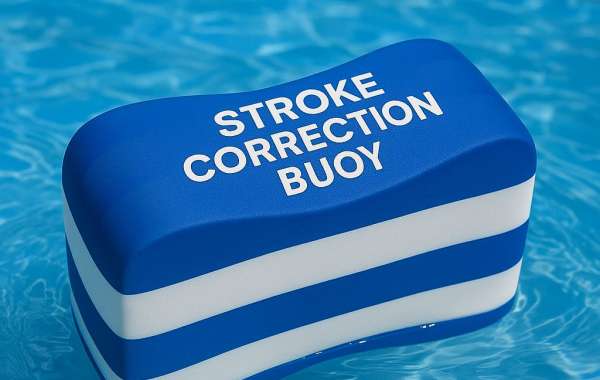A stroke correction buoy is a smart training tool used in swimming to help swimmers improve their stroke techniques. It is usually placed between the legs, around the thighs or knees, and it helps in balancing the body while keeping the legs afloat. This small yet effective equipment is widely used by both beginner and professional swimmers. It helps reduce drag in the water and keeps the body aligned, making it easier to focus on arm movement and stroke efficiency. Using a stroke correction buoy can help correct common swimming mistakes like body rotation, crossing arms, and improper breathing. It is designed to promote better body posture, better stroke timing, and overall swimming efficiency.
In this article, we’ll explore everything about stroke correction buoys – their benefits, usage, types, techniques, and expert tips. If you want to become a better swimmer, this guide will surely help you.
What Does a Stroke Buoy Do?
A stroke correction buoy helps improve body position in the water. When swimming, many beginners and even advanced swimmers often struggle with keeping their hips and legs from sinking. This problem affects speed and efficiency. A buoy helps correct this issue by providing lift and support to the lower body.
The buoy is typically placed between the thighs or knees. Once in position, it stops the legs from kicking and keeps them afloat. This allows the swimmer to concentrate fully on their arm strokes and breathing without worrying about leg movement. Over time, using the buoy builds muscle memory for correct body alignment.
A stroke correction buoy also makes training more focused. It encourages swimmers to pay attention to their upper body movements. Coaches often recommend using the buoy for specific drills, especially during freestyle or front crawl training. It helps identify and fix imbalances in stroke technique.
In summary, a stroke correction buoy is more than just a floatation device. It trains the swimmer’s body to stay streamlined and balanced, leading to better performance in the water.
Benefits of Using Stroke Correction Buoy
Using a stroke correction buoy offers several benefits to swimmers of all levels. One of the main advantages is improved body alignment. By keeping the lower body lifted, the buoy helps the swimmer stay flat and horizontal in the water. This reduces resistance and allows smoother, more efficient strokes.
Another big benefit is that it isolates the arms. When the legs are not kicking, the swimmer can focus more on pulling technique, hand placement, and stroke power. This type of isolation helps build upper body strength and better stroke control.
The buoy also supports learning proper breathing techniques. Since the body is more stable with a buoy, the swimmer can turn their head for breath without disturbing the body’s balance. This leads to better timing and rhythm during breathing.
Stroke correction buoys are also useful for building endurance. By making training more intense and focused, they help swimmers develop stamina. They are often used in drills where multiple laps are completed using only arms. This challenges the swimmer’s cardiovascular and muscular systems.
Overall, the benefits of using a stroke correction buoy include better form, stronger strokes, improved breathing, and increased endurance. These are key elements in becoming a more efficient and confident swimmer.
How to Use the Buoy Correctly
Using a stroke correction buoy correctly is important to get the most out of your swim training. First, place the buoy between your thighs or knees before starting your swim. Make sure it fits snugly and doesn’t fall out while you move.
Once it is in place, begin swimming using only your arms. Do not kick your legs. Let the buoy support your lower body. Focus on making long, smooth arm pulls. Try to keep your head steady and look straight down into the water. This will help you maintain proper body alignment.
While using the buoy, pay attention to your hand entry and underwater pull. Keep your arms wide enough to avoid crossing the center line of your body. Use your core muscles to stay balanced and streamlined.
It’s also important to breathe correctly. Turn your head smoothly to the side to take a breath. Do not lift your head forward as it can affect your balance.
Use the buoy for specific sets during your workout. You can swim 100 meters with the buoy, then switch to normal swimming, and repeat. This mix helps build endurance and technique at the same time.
Remember to relax your body and avoid overthinking. The goal is to build better habits through repeated practice with the buoy.
Different Types of Stroke Correction Buoys
Stroke correction buoys come in various shapes, sizes, and materials. Choosing the right one depends on your comfort, body size, and training goals.
The most common type is the classic hourglass-shaped buoy. It fits comfortably between the legs and provides good buoyancy. These are great for beginners and are easy to use.
There are also ergonomic buoys designed with grooves or adjustable straps. These give a more secure fit and prevent slipping during intense workouts. They are perfect for competitive swimmers or those who swim long distances.
Some buoys are made with extra foam layers for added floatation. These are good for heavier swimmers who need more lift in the water.
Advanced models include smart stroke correction buoys. These may have built-in sensors that track your movements and give feedback on your swim technique. These are useful for professional training but can be expensive.
It’s important to test different buoys and find one that suits your body and training style. A buoy that is too small or too large may not be effective. Comfort and fit are key when choosing the right stroke correction buoy.
Common Mistakes While Using Buoy
Using a stroke correction buoy can be very effective, but only if used correctly. A common mistake is squeezing the buoy too tightly between the legs. This creates unnecessary tension and affects body balance. The buoy should rest gently and hold its place with minimal effort.
Another mistake is kicking the legs while the buoy is in use. The purpose of the buoy is to stop leg movement so that you can focus on your upper body. Kicking defeats the purpose and reduces the benefits.
Some swimmers also lift their heads while breathing, which throws off body alignment. Always try to rotate the head smoothly to the side.
Using the buoy for too long without breaks can also lead to fatigue and muscle imbalance. It's best to use it in short sets, mixed with normal swimming.
Lastly, swimmers often ignore their core. Even with a buoy, your core muscles should be active to maintain a straight line from head to toe.
By avoiding these common mistakes, you’ll gain more from using your stroke correction buoy and improve your swim performance effectively.
Expert Tips for Better Buoy Training
If you want to make the most out of your stroke correction buoy training, here are some expert tips. First, always warm up before using the buoy. Start with a few laps of normal swimming to get your muscles ready.
Use the buoy for focused drills. For example, do 4 sets of 100 meters using only your arms. Take short breaks between each set. This will help build strength and stamina.
Mix in different strokes while using the buoy. While freestyle is the most common, you can also try backstroke or butterfly drills to target different muscles.
Record yourself or swim in front of a mirror if possible. Watching your form helps identify bad habits. Many professional swimmers use video analysis to improve technique.
Swim with a training partner or coach. They can give you feedback on your form and guide you during drills. Having support can boost motivation and help you progress faster.
Lastly, don’t forget to stay consistent. Improvement takes time. Use the stroke correction buoy regularly but always balance it with full-body swimming.
Conclusion: A Must-Have Tool for Swimmers
The stroke correction buoy is one of the simplest yet most powerful tools in a swimmer’s training kit. It helps with body alignment, builds arm strength, improves breathing, and boosts confidence in the water. Whether you are just learning to swim or training for a competition, the buoy can take your skills to the next level.
By understanding how to use it correctly, choosing the right type, and avoiding common mistakes, you’ll get the most benefits. Remember, swimming is all about technique, and small changes can make a big difference. Make the stroke correction buoy a part of your regular practice, and you’ll see the improvement for yourself.
Questions and Answers
Q1. Can beginners use a stroke correction buoy? Yes, stroke correction buoys are perfect for beginners. They help improve body balance and allow new swimmers to focus on learning strokes without worrying about leg movement.
Q2. How long should I use the buoy during training? It’s best to use the buoy in short sets, such as 100 to 200 meters per set. Mix buoy drills with normal swimming to avoid muscle imbalance.







